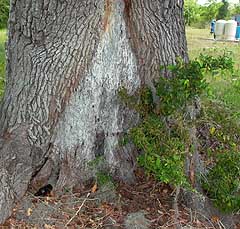Home > Tree structure basics > Structural defects > Hollows and cavities
Hollows and cavities
 Cavities
and hollows in trunks and branches are typically the
result of decay that followed injury. The injury often occurred many years ago
(see photo). Injuries could include removing a branch with a pruning
cut made too close to the trunk, removing a large
branch, large branch breakage, topping the trunk or branches, cutting a large root or
a group of roots (see right photo), or damaging the trunk.
Cavities
and hollows in trunks and branches are typically the
result of decay that followed injury. The injury often occurred many years ago
(see photo). Injuries could include removing a branch with a pruning
cut made too close to the trunk, removing a large
branch, large branch breakage, topping the trunk or branches, cutting a large root or
a group of roots (see right photo), or damaging the trunk.
In the old days, cavities were filled with concrete in hopes that this would strengthen the trunk. We now know that this actually causes more injury to the tree. Additional injury occurs when the tree continues to move normally in the wind against the stiff concrete column inside. This abrasion allows decay to move into the living wood by injuring the barrier zone formed by the tree to retard further advance of decay. Never use concrete in trees.
Cavities do not have to be filled. Spray insulation has been used to keep animals and children out of cavities. This should not injure the tree as long as the walls of the cavity are not injured during the repair process. Do not attempt to clean out the inside of the cavity or hollow. Do not drill holes in the bottom of the cavity to remove water. This is likely to spread decay to healthy living portions of the tree.
If a tree has a cavity or hollow and is near a building or area used by people, have it checked by a competent arborist. Hollow trees are not always at risk of falling down but they can be if the tree lacks enough healthy wood to keep it standing. Ample woundwood growth on either side of the hollow (as shown above right) can compensate somewhat for the weakness represented by the decay. This wood often is stronger than normal trunk wood.
Many arborists have come to understand that a tree trunk can loose
up to about 70% of its wood cross-sectional area in the center and still retain
about two-thirds of its strength provided there are no openings in the trunk.
When there is an opening in the trunk (a cavity as shown above) the tree is typically regarded
as even weaker. Specially designed tools operated
by trained personnel can help determine the amount of decay in trees.

